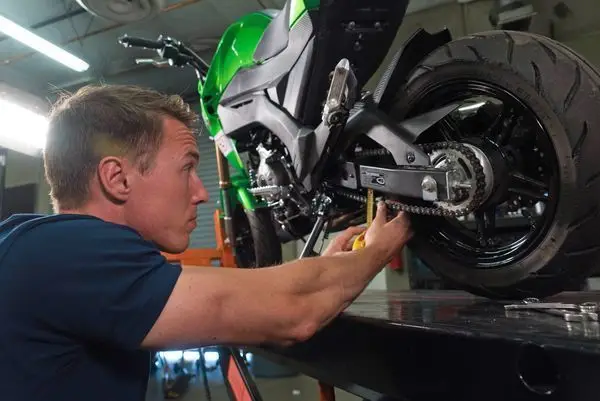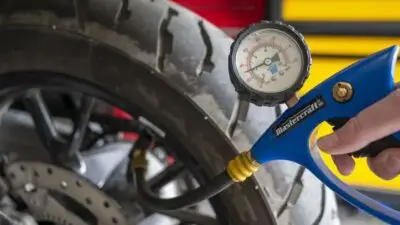Keeping your motorcycle chain at the right tension is one of the most basic maintenance tasks every rider should know. A chain that’s too loose can jump off the sprockets, while one that’s too tight can cause excess wear on your drivetrain components. Checking your chain’s slack involves simply pushing up and pulling down on the bottom run of the chain midway between the sprockets, then measuring the total movement, which should typically be between 1-1.5 inches depending on your bike’s specifications.

Adjusting your chain tension is straightforward once you know the steps. Most motorcycles have adjustment bolts at the rear axle that allow you to move the rear wheel backward or forward to achieve the proper tension. This simple maintenance task can extend the life of your chain, sprockets, and even your motorcycle’s transmission.
Key Takeaways
- Check chain tension regularly by measuring the total vertical movement at the midpoint between sprockets.
- Proper adjustment requires loosening the axle nut and turning adjustment bolts evenly on both sides.
- Always refer to your motorcycle’s manual for the exact specifications and perform a final alignment check after adjustments.
Understanding Motorcycle Chain Tension

Chain tension is a critical aspect of motorcycle maintenance that affects performance, safety, and the longevity of your drivetrain components. Proper tension ensures optimal power transfer while preventing unnecessary wear on your motorcycle’s chain and sprockets.
What Is Chain Tension?
Chain tension refers to the amount of slack or play in your motorcycle’s drive chain. It’s measured as the vertical movement possible in the bottom run of the chain. This slack is typically measured in millimeters or inches between the fully tight and fully loose positions.
Most motorcycles require between 20-40mm (¾-1½ inches) of chain slack, though specific measurements vary by manufacturer and model. The correct tension allows the chain to flex as the suspension moves through its travel.
Chain tension is affected by:
- Riding conditions
- Chain wear and elongation
- Rear wheel alignment
- Suspension movement
The chain will naturally stretch over time, requiring periodic adjustments to maintain proper tension throughout its service life.
The Importance of Proper Chain Tension
Proper chain tension is fundamental maintenance, as important as checking oil levels and tire pressure. Correct tension ensures efficient power transfer from the engine to the rear wheel.
When properly tensioned, a chain:
- Reduces friction between chain links and sprocket teeth
- Minimizes power loss during acceleration
- Extends the life of both chain and sprockets
- Maintains smooth operation at all speeds
Chain tension directly affects suspension performance. Too tight, and the chain restricts suspension movement. Too loose, and it can cause erratic power delivery.
Different riding conditions may require slight adjustments. For high-speed highway riding, a slightly tighter chain might be preferred, while off-road riding might benefit from additional slack to accommodate suspension travel.
Consequences of Incorrect Chain Tension
Improper chain tension leads to numerous problems that can affect safety, performance, and maintenance costs. When a chain is too tight, it creates excessive friction and binding.
Problems with overtightened chains:
- Accelerated wear on chain links and sprocket teeth
- Increased load on the transmission output shaft bearings
- Restricted suspension movement
- Potential chain breakage under load
When a chain is too loose, it can slap against the swingarm and chain guard, causing:
- Unpredictable power delivery
- Risk of the chain jumping off sprockets
- Damage to engine cases if the chain derails
- Excessive noise and rough operation
Regular inspection is necessary because chain length naturally increases with use. A properly adjusted chain provides optimal performance while minimizing the risk of catastrophic drivetrain failure during operation.
Tools and Equipment Needed

Having the right tools on hand makes checking and adjusting your motorcycle chain both easier and more accurate. Proper equipment ensures you can complete this essential maintenance task correctly the first time.
Essential Tools for Chain Adjustment
A torque wrench is absolutely necessary for this job. It allows you to properly tighten the axle nut to manufacturer specifications, preventing damage to your bike. Most motorcycles require between 65-80 ft-lbs of torque for the rear axle.
You’ll need the correct socket sizes that fit your specific motorcycle’s axle nut and adjuster bolts. These typically range from 14mm to 24mm depending on your bike model.
A good quality ruler or tape measure helps you check the chain slack accurately. Metal rulers work best as they won’t bend when pressed against the chain.
Basic hand tools including wrenches and socket sets are required to loosen the axle and adjustment nuts. Make sure they fit your bike’s specific hardware.
Optional Tools for Enhanced Accuracy
A dedicated chain tension tool provides more consistent measurements than a basic ruler. These specialized tools hook onto your chain and provide precise slack readings that are easier to interpret.
A rear stand elevates your motorcycle’s back wheel, making chain adjustments significantly easier. This allows the wheel to spin freely while you check alignment and tension.
Alignment markers or a laser alignment tool help ensure your rear wheel remains perfectly aligned with the front. Misalignment causes uneven tire wear and poor handling.
A small flashlight improves visibility in the often dark areas around the chain and sprockets. This helps you spot potential issues like tight links or excessive wear.
Preparing Your Motorcycle for Chain Inspection

Before checking your chain tension, you need to set up your motorcycle properly. This preparation ensures accurate measurements and makes the task safer and easier to complete.
Choosing a Safe Work Area
Find a flat, level surface for chain inspection. A garage floor or driveway works well as long as it’s clean and free of debris. Good lighting is essential – use a flashlight or work light if natural light isn’t sufficient.
Make sure you have enough space to move around the motorcycle. You’ll need to access both sides of the rear wheel and the swingarm area. Have your tools ready before you start – typically you’ll need:
- A ruler or tape measure
- Appropriate wrenches for your specific motorcycle
- Gloves to protect your hands from grease and dirt
The work area should be stable enough that the motorcycle won’t shift during your work. Avoid soft surfaces like grass or gravel.
Using the Side Stand or Center Stand
The side stand is not ideal for chain adjustment as it puts the motorcycle at an angle. This can give inaccurate chain slack measurements. However, if you only need to inspect the chain, the side stand may suffice.
For proper adjustment, use the center stand if your motorcycle has one. The center stand lifts the rear wheel off the ground and keeps the bike perfectly upright, allowing for precise measurements.
If your motorcycle lacks a center stand, consider using:
- A rear paddock stand
- A motorcycle lift
- A secure rear wheel chock with assistance
Position the stand near the swing arm pivot for optimal stability. This provides a solid foundation while you work. Check that the motorcycle is secure before beginning any maintenance work.
How to Inspect Chain Tension

Proper chain tension is critical for motorcycle safety and performance. Checking your chain regularly prevents premature wear of both the chain and sprockets while ensuring smooth power delivery.
Locating and Assessing the Chain
The chain is located on the left side of most motorcycles, connecting the engine’s output sprocket to the rear wheel. To properly assess chain tension, place your motorcycle on its side stand or center stand. Some manufacturers recommend checking tension with no weight on the bike, while others specify having the rider’s weight on it.
Look for the area midway between the front and rear sprockets. This is the optimal spot to check chain tension. Make sure the bike is in neutral before handling the chain.
Visual inspection is important too. Check for rust, kinked links, or obvious damage that might indicate problems beyond just tension issues.
Measuring Chain Free Play
Free play (or slack) refers to how much the chain moves up and down when pushed. To measure it correctly:
- Find the middle point between sprockets
- Push the lower run of the chain upward
- Measure the distance between the fully slack position and the no-slack position
Most motorcycles require between 20-30mm (¾ to 1¼ inches) of free play in the middle of the chain. However, always check your owner’s manual for the exact specifications for your bike model.
You can use special tools like a Chain Monkey for precise measurement, or simply use a ruler or tape measure. The chain should never be too tight or too loose.
Identifying Chain Wear and Stretch
Chains naturally stretch as they wear. This stretching increases free play and requires periodic adjustment. Signs of excessive chain wear include:
- Visible stretching: Chain appears longer than when new
- Stiff links: Links that don’t bend smoothly
- Rust or corrosion: Indicates poor lubrication
- Noise: Squeaking or grinding sounds while riding
To check for stretch, pull the chain away from the rear sprocket. If you can see daylight between the chain and sprocket teeth, your chain is stretched and may need replacement.
A chain that requires frequent adjustment (more than every 500 miles) is likely worn out. Most motorcycle chains last between 15,000-25,000 miles with proper maintenance.
Adjusting the Chain Tension

Proper chain tension is critical for motorcycle safety and performance. Adjusting your chain requires attention to detail and the right tools to ensure optimal operation.
Loosening the Axle and Adjusters
Begin by placing your motorcycle on a stand to lift the rear wheel off the ground. This gives you better access and allows the wheel to spin freely during adjustments.
Locate the axle nut on the rear wheel and loosen it using the appropriate socket wrench. Don’t remove it completely—just loosen it enough so the wheel can move.
Find the chain adjusters on both sides of the swingarm. These usually have lock nuts that need to be loosened first. Loosen these lock nuts using a wrench, turning counterclockwise.
Some motorcycles have markers or graduation marks on the adjusters to help with alignment. Take note of the current position before making any changes.
Setting the Correct Chain Slack
Refer to your motorcycle’s manual for the recommended chain slack specification. This typically ranges between 20-30mm (¾-1¼ inches) depending on your bike model.
To measure the slack, push up on the bottom of the chain and note the distance between the full-slack position and the no-slack position. This is your current chain slack measurement.
Turn the adjuster nuts on both sides equally to increase or decrease tension. Turning clockwise tightens the chain (reduces slack), while counterclockwise loosens it (increases slack).
Make small adjustments at a time, then re-check the chain tension by measuring slack at multiple points. This ensures even tension throughout the chain’s length.
Aligning the Rear Sprocket with the Chain
Proper alignment between the chain and sprockets is just as important as correct tension. Misalignment causes premature wear and can be dangerous.
Check that the alignment marks on both sides of the swingarm match exactly. Uneven adjustments will cause the rear wheel to sit at an angle, misaligning the rear sprocket with the front sprocket.
Most motorcycles have alignment indicators on the swingarm. Ensure the same mark on each side aligns with the reference point.
After making adjustments, tighten the axle nut to the manufacturer’s specified torque. Then secure the lock nuts on the adjusters while maintaining your settings.
Spin the rear wheel and observe the chain’s movement. It should run smoothly without binding or jumping on the sprockets. Listen for any unusual noises that might indicate misalignment.
Special Considerations for New Chains

New motorcycle chains require specific attention to ensure proper performance and longevity. The break-in period is critical, as initial stretching occurs rapidly and tension requirements differ from those of seasoned chains.
Adjusting Chain Tension After Initial Break-In
New chains stretch significantly during the first 500-1,000 miles of use. This phenomenon, called “initial stretch,” happens as the chain components seat themselves properly during early operation.
After installing a new chain, check the tension after the first 100 miles of riding. During this period, you may need to make adjustments more frequently than the standard 500-mile interval recommended for established chains.
When adjusting a new chain, follow these steps:
- Measure the initial chain slack
- Ride for 100 miles
- Re-measure the slack (expect it to increase)
- Adjust to manufacturer specifications
- Repeat this process until stretch stabilizes
Some riders prefer to set new chains slightly tighter than the manufacturer’s specs, accounting for the expected stretch. However, never set chain tension too tight as this can damage the transmission and bearings.
Signs of Improper Chain Adjustment on New Chains
A new chain with improper tension will display warning signs before causing significant damage. Being vigilant about these indicators can prevent costly repairs.
Too tight chain symptoms:
- Binding feeling when rotating the rear wheel by hand
- Whining or grinding noises during operation
- Increased resistance when changing gears
- Accelerated sprocket wear patterns
Too loose chain symptoms:
- Visible excessive chain slack that changes dramatically with suspension position
- Slapping noises against the swingarm
- Chain jumping teeth on the sprocket
- Inconsistent power delivery
The ideal tension for a new chain typically allows for about 1-1.25 inches (25-32mm) of vertical movement at the midpoint between sprockets. This measurement should be taken with the bike’s suspension in its normal riding position, not on a stand with the suspension unloaded.
Primary Chain and Chain Drive Variations

Motorcycles often feature different chain systems that require specific adjustment techniques. The primary chain connects the engine to the transmission, while different drive systems have unique maintenance requirements.
Understanding Primary Chain Adjustment
The primary chain on most motorcycles sits inside the primary case and requires proper adjustment to ensure optimal performance. Unlike the final drive chain, checking and adjusting the primary chain involves working with components housed within the motorcycle’s engine case.
Primary chain tension is critical – too loose and it can slap against the case causing damage; too tight and it creates excessive wear on bearings and sprockets. Most manufacturers specify between 3/8″ to 1/2″ of play, but this varies by model.
Some motorcycles, particularly Harley-Davidson models, use specialized tools like the BAKER Armored Attitude Adjuster for precise adjustment. Riders should consult their owner’s manual for specific measurements and adjustment procedures for their motorcycle.
Inspecting the Primary Chain
Regular inspection helps prevent primary chain drive failures that can leave riders stranded. Inspection should focus on:
Signs of wear to check for:
- Excessive looseness or tightness
- Missing or damaged O-rings
- Rust or corrosion
- Stiff links that don’t move freely
- Metal particles in the primary oil
Proper inspection requires draining some or all of the primary fluid to visually examine the chain. The chain should move freely without binding but shouldn’t have excessive play.
After adjusting the primary chain, riders should check it again after a short ride as new adjustments often settle during initial operation.
Accessing the Inspection and Clutch Covers
Accessing the primary chain requires removing the inspection cover or clutch cover, depending on the motorcycle model. This process varies significantly between motorcycle types.
Most motorcycles have dedicated inspection covers secured with several bolts. Before removing any covers, place an oil catch pan underneath to collect fluid that will drain out.
Tools typically needed:
- Appropriate sized wrenches or socket set
- Torque wrench
- New gaskets or sealant
- Clean rags
- Primary fluid for refilling
Riders should carefully follow the torque specifications when reinstalling covers. Over-tightening can crack cases while under-tightening may cause leaks. Some covers require a specific tightening sequence to prevent warping.
After completing maintenance, the primary case must be refilled with the correct type and amount of fluid as specified in the owner’s manual.
Final Checks and Safety Tips

After adjusting your motorcycle chain, performing proper final checks is crucial for your safety on the road. Attention to detail in these last steps will help prevent mechanical issues and ensure a smooth ride.
Rechecking Alignment and Torque
Always verify chain alignment after any adjustment. Look at the alignment marks on both sides of the swingarm to ensure they match exactly. If the marks don’t align, your wheel isn’t straight, which can cause handling problems and premature chain wear.
Use a torque wrench to tighten the axle nut to the manufacturer’s specifications. Over-tightening can damage threads while under-tightening may cause the wheel to become loose during riding. Most motorcycles require between 65-85 ft-lbs of torque for the rear axle.
Check both chain adjusters to confirm they’re in identical positions. This prevents the wheel from sitting at an angle in the swingarm. Misalignment can cause:
- Uneven tire wear
- Poor handling characteristics
- Increased chain noise
- Accelerated sprocket wear
Securing the Axle and Locknuts
After tightening the axle to proper specifications, secure all locknuts and safety devices. Tighten the adjuster locknuts firmly against the adjusters to prevent any movement during riding.
If your motorcycle has a cotter pin for the axle nut, replace it with a new one. Never reuse old cotter pins as they can weaken when bent. Make sure the pin’s legs are properly spread to prevent it from working loose.
Some motorcycles use axle pinch bolts instead. These require specific torque settings, usually between 15-25 ft-lbs. Check your owner’s manual for the exact specification.
Apply a small dab of thread-locking compound to any bolts without safety devices. This prevents vibration from loosening them during normal operation.
Test Riding After Adjustment
Take your motorcycle for a test ride after completing all adjustments. Start with a slow ride around a parking lot to check for any unusual noises or vibrations.
Listen for any clicking or grinding sounds which may indicate the chain is too tight. A properly adjusted chain should have a slight but not excessive movement.
Apply gentle acceleration and braking to ensure smooth power transfer. Pay attention to how the bike handles during these maneuvers.
After 5-10 minutes of riding, park the motorcycle and check if any fasteners have loosened. Also verify the chain tension hasn’t changed significantly from your adjustment.
Recheck the chain temperature. It should be warm but not excessively hot. Excessive heat indicates too much tension or insufficient lubrication.
Frequently Asked Questions

Chain maintenance questions commonly arise for motorcycle owners. Proper tension affects both performance and safety while incorrect adjustment can damage your bike’s drivetrain components.
What are the symptoms of a loose motorcycle chain?
A loose motorcycle chain often produces a slapping noise against the swingarm during acceleration. This distinctive sound is usually the first warning sign riders notice.
You might also experience jerky power delivery or hesitation when rolling on the throttle. The bike may lurch forward unpredictably as the slack is taken up.
Visible excessive movement in the chain when inspecting the bike at rest is another clear indicator. If the chain hangs significantly lower at its midpoint than at the sprockets, it needs adjustment.
How can you tighten a motorcycle chain without using a stand?
Find a level surface and place the bike on its side stand. This position allows enough access to work on the chain while keeping the bike stable.
Have someone sit on the motorcycle to create the proper weight distribution before measuring slack. This mimics actual riding conditions for a more accurate adjustment.
Loosen the rear axle nut first, then adjust the chain tensioners on both sides of the swingarm evenly. Tighten the axle nut to specification after achieving proper tension.
What tools are needed to measure the slack in a motorcycle chain?
A ruler or tape measure is essential for accurate slack measurement. Digital calipers can provide even more precise readings if available.
The motorcycle’s owner manual contains specific chain slack specifications. Keep it handy as a reference during adjustment.
Basic hand tools including wrenches or sockets for the axle nut and adjustment bolts are necessary. Some bikes require specialized tools, so check your manual before starting.
What is the proper method for checking the tension of a motorcycle chain?
Position the motorcycle on level ground using the side stand or center stand if available. The bike should be in neutral gear.
Locate the section of chain with the least amount of slack by rotating the rear wheel slowly. This identifies the tightest point in the chain.
Push up on the bottom run of the chain at its midpoint between sprockets and measure the total vertical movement. Compare this measurement to specifications in your owner’s manual.
How can you tell if a motorcycle chain needs tightening?
Excessive chain movement while riding often manifests as a rhythmic clunking or banging noise. This sound typically increases with speed.
Visual inspection reveals significant downward sag in the lower run of the chain. More than the manufacturer’s recommended movement indicates adjustment is needed.
Chain slap marks on the swingarm or chain guard suggest the chain has been hitting these components due to excessive slack. Fresh marks indicate recent contact.
What is the standard procedure to calculate the correct chain slack for your motorcycle?
Consult your motorcycle’s owner manual for the exact specification. Most manufacturers provide a range, typically between 20-30mm (0.8-1.2 inches) of vertical movement.
Consider your riding style and conditions when setting chain tension. Sport riding may benefit from the tighter end of the specification, while off-road riding often requires slightly more slack.
Measure at the midpoint between the front and rear sprockets. The slack should be consistent with the manufacturer’s specifications when pushing up on the lower run of the chain.



